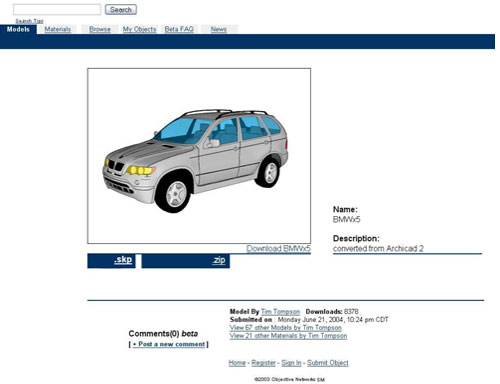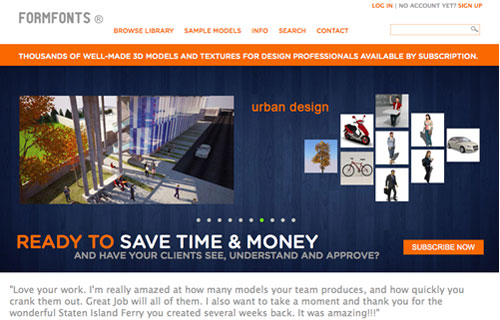Form Fonts is our go-to subscription based collection of 3d models and textures. I have been a member of Form Fonts for the last 9 years and I absolutely cannot exist without this service as a professional designer and visualization artist. The amount of time I save and the value added to my 3d presentations is unmeasurable.
One of my favorite features of Form Fonts is that you can search generic terms like “cars” or “coffee table”, and also brand specific terms such as “Audi” or “Design Within Reach”. The collections are enormous and the quality of the models is unmatched. Form Fonts models and textures look excellent in SketchUp and photo-real rendering programs.
Recently we had a chance to chat with Fred Abler, CEO of Form Fonts, to better understand how this resource came to be. Visit Form Fonts here to browse the collections and sign up.
FormFonts 3D : A Decade of Serving Up 3D Models!
Editors Note: As FormFonts 3D is turning 10, we thought it might be interesting to review the history of the pioneer of 3D Model Stock for SketchUp. This is an interview with Fred Abler, CEO of FormFonts.com.
SketchUp Magazine: How and when did FormFonts get started?
Abler: In 2001, I was working at the CAD Research Center at Cal Poly, San Luis Obispo, CA where I had done my architecture degrees. We developed some pretty cool agent-based spatial decision support systems. But over time, the lab basically became a military defense contractor. I wanted to get back to into architecture, and I was especially keen on the potential for ‘smart objects’ in architecture.
A friend at ESRI introduced me to SketchUp, and I was immediately taken by this little 3D modeler. It was just a joy to use. It was only for visualization of course, but that’s where the marketplace was in 2001. At the time I was also on a campus committee for Internet2 Research - a consortium of 260 universities worldwide connected by a super-fast fiber-optic research network.
Because Internet2 promised unlimited bandwidth, I began to wonder what impact capacious bandwidth would have on 3D modeling. It occurred to me that the effects would be significant.

Of course we all had BIM-like dreams. But where to start? At the time, huge 3D CAD libraries came on-disc with shrink-wrapped software, or were sold separately. These ‘block libraries” were pretty basic, outdated the minute you installed them, and they took up significant amounts of disc space.
Sketchup was really the first “downloadable” 3D modeler. So I thought: Wouldn’t it be great if you didn’t have to download all those stock models? You should just be able to go out to the web, search for what you want, and then download just what you need. And because everyone would be able to download the very latest version of a SketchUp component, it would actually be practical to update the 3D model library on an ongoing basis.
SketchUp Magazine : What today we would call “the Cloud” and/or “Software As A Service”.
Fred Abler: Yes, exactly. But in early 2000’s we didn’t have the cloud yet. It was called a “Service Oriented Architecture”.
SketchUp Magazine: So how did you test your idea for a 3D Content Cloud?
Abler: I approached @Last Software in Boulder, Co. and very enthusiastically pitched them on my idea for a ‘living library of 3D SketchUp components”. I hired a Computer Science student (Paul Thormahlen) at Cal Poly to write the software for a 3d model server and called it “Objective Networks”. I paid for everything out of my own pocket, and designed ObjectiveNetworks.com so users could upload their own models, and share them with the SketchUp community.
SketchUp Magazine: Did you charge for this, or was it free?
Abler: It was all completely free. At that time it was still unthinkable to charge for anything on the Internet.
SketchUp Magazine: Why do you think ObjectiveNetworks ultimately worked?
There was nothing else like it at the time. TurboSquid was the only player and they charged pretty dearly for their high-poly models. So being first helped a lot. But I also decided that we should show the number of downloads for each contributor’s model, kind of as a way to thank them for sharing their model in the first place.
We had some amazing modelers who were very generous like Markus Sillander, Anri JoJo, and Alan Fraser, etc. Word got out pretty quickly you could score free 3D models on Objective Networks, and the SketchUp community was still very small (by today’s standards). So fans would upload their sketchup components to Objective Networks, and the model counts would rise almost instantly. In fact, a little too quickly.

Fig 2. Objective Networks screen shot (c. 2003 ) showing free 3D SketchUp Components. Objective Networks was the forerunner to the Sketchup 3D Warehouse, and FormFonts 3D.
This made me take a closer look at the Downloads count, and I discovered something pretty interesting. As soon as an artist uploaded their model to share, they would do something very strange. They would instantly turn-around and download it themselves 10 or 15 times.
Apparently, artists didn’t want anyone to think their model was “un-loved” or “no-good” so they primed the pump! This was fine with me if the artists wanted to provide a little of their own social proof. In the three years ObjectiveNetworks was online, we served out almost 5,000,000 free 3D components to the nascent SketchUp Community.
SketchUp Magazine: And didn’t @Last Software give you some grant money at some point?
Abler: Yes,I demonstrated a private beta version of Objective Networks to Brad Schell at an ESRI conference in 2002. And when I showed them how you could drag ‘n drop a 3D model from ObjectiveNetworks.com directly into the SketchUp workspace, they almost fell on the floor laughing with delight.
After that. I asked @Last for some grant money and they graciously gave me $5,000. I took the grant money to the Dean of Research at Cal Poly SLO, and she matched it with in-kind equipment and bandwidth, and, that’s how we got our first server.
SketchUp Magazine: So then, How did ObjectiveNetworks become FormFonts.com?
Abler: As ObjectiveNetworks got larger and larger, the limits of crowdsourcing became painfully obvious. We tried several ways to get the crowd to help us quality-control the models. But all of these efforts were unsuccessful.
After awhile, the brilliant modelers that were contributing to ObjectiveNetworks started to get a bit resentful. They didn’t like the fact that their work was surrounded by junky models people had scrounged up somewhere. And the imbalance between “givers and takers” became too hard to ignore. So many more people were downloading models than uploading them, that it started to feel truly unfair to those that were contributing.
As it got worse and worse, the model quality just became almost random. And in many ways, ObjectiveNetworks became a victim of it’s own success. The more people that used it, the worse it got. It’s the same complaint a lot of people still have with free sites today.
So the choice was to shutter the site, or turn “pro” and use the lessons learned from the free site as a kind of test marketing. I eventually chose the latter, and then began contacting a few of the most talented 3D modelers in the world at the time (Alan Fraser, Allister Godfrey, Nino Alvarez, etc.).
Most of these guys were already selling small collections of their own models on CD, and Alister had even started a small website. But the community reaction to actually charging for 3D content had been pretty hostile, so everyone pretty much said they would gladly throw in their lot with me, should I started a commercial version of Objective Networks
SketchUp Magazine: So you started FormFonts.com in 2004?
Abler: Yes, while ObjectiveNetworks was still serving out free 3D models, I hired Cal Poly students to develop a ‘subscription’ version of ObjectiveNetworks. I also asked my architecture classmate Marc Frederickson, to invest and partner with me in starting FormFonts.
Marc provided most of the initial capital we needed to set up commercial grade servers, software development, hosting, accounting etc. Today Marc is what I call our Chief Operations Officer. But Marc doesn’t really like titles, so let’s just say he wears many hats.
When FormFonts became the first website to sell 3D content by subscription, most everyone thought (and a few said openly) that we would fail. In 2004 paid content was pretty much an unknown, and selling content on CDs was the established norm.
But in retrospect, we really didn’t have a choice in the matter. The subscription model was the only thing we could do. We couldn’t charge much money without a serious backlash, and we just didn’t have that many 3D models to begin with.

Fig 3. Splash page of FormFonts.com today.
We couldn’t leverage the thousands of Objective Networks 3D models because the quality was so variable. And we only had about 120 professionally made models when we launched FormFonts 3D, so we couldn’t charge much. I decided to ask $33 and make the subscription period just 3 months, and automatically renewing.
Fortunately, we got the price right and our best was spot on. There was simply no other place you could get professionally made SketchUp components at the time. So once people tried and liked our professional 3d models, they decided to stay with us.
SketchUp Magazine: So ten years on, how many 3D models do you have, and what does your subscriber base look like today?
Abler: FormFonts has more than 50,000 3D models and assets under management. Our annual subscription has been $199 for 5 years now. We’ll probably need to raise our subscription rates a bit next year, provided the economy keeps improving.
SketchUp Magazine: And who are your customers?
About 70% of our subscribers are architects, landscape architects, contractors and other AEC design professionals. 20% are in the entertainment industry (film and tv production designers) and 10% are various design professionals (e.g. trade-show booth and event designers).
We also of course support many more file formats now, so our 3D model library is available to a much larger universe of 3D modelers, not just SketchUp users.
SketchUp Magazine : So what will the next 10 years look like for FormFonts?
Abler: The subscription model has been very very good to us, and FormFonts will keep improving our service in some new and interesting ways. We also have been asked to expand the types of 3D models we make, and we’re currently moving into 3D geo-content and mapping.
Editors Note: Please check in how FormFonts 3D is doing today, and visit their website
www.formfonts.com
www.formfonts.com
~~~~~~~~~~~~~~~~~~~~~
Published By
Rajib Dey
~~~~~~~~~~~~~~~~~~~~~
No comments:
Post a Comment